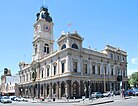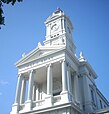| Ballarat balla arat (Wathawurrung) Victoria | |||||||||
|---|---|---|---|---|---|---|---|---|---|
| Coordinates | 37°33′39″S 143°50′51″E / 37.56083°S 143.84750°E | ||||||||
| Population | 119,096 (2024) (19th) | ||||||||
| • Density | 346.61/km2 (897.72/sq mi) | ||||||||
| Established | 1838 | ||||||||
| Postcode(s) | 3350 | ||||||||
| Elevation | 435–630 m (1,427–2,067 ft) AHD | ||||||||
| Area | 343.6 km2 (132.7 sq mi)[1] (2016 census – SUA) | ||||||||
| Time zone | AEST (UTC+10) | ||||||||
| • Summer (DST) | AEDT (UTC+11) | ||||||||
| Location | |||||||||
| LGA(s) | City of Ballarat | ||||||||
| Region | Grampians | ||||||||
| State electorate(s) | |||||||||
| Federal division(s) | Ballarat | ||||||||
| |||||||||
Ballarat (/ˌbæləˈræt/ BAL-ə-RAT)[2] (Wathawurrung: balla arat)[3] is a city in the Central Highlands of Victoria, Australia. Ballarat has a population of 119,096[4] as of March 2024 making it the third-largest urban inland city in Australia and the third-largest city in Victoria.
Within months of Victoria separating from the colony of New South Wales in 1851, gold was discovered near Ballarat, sparking the Victorian gold rush. Ballarat subsequently became a thriving boomtown that for a time rivalled Melbourne, the capital of Victoria, in terms of wealth and cultural influence. In 1854, following a period of civil disobedience in Ballarat over gold licenses, local miners launched an armed uprising against government forces. Known as the Eureka Rebellion, it led to the introduction of white male suffrage in Australia, and as such is interpreted as the origin of Australian democracy. The rebellion's symbol, the Eureka Flag, has become a national symbol.
Proclaimed a city on 9 September 1870,[5] Ballarat's prosperity, unlike that of many other gold boomtowns, continued until the late 19th century, as the city's fields experienced sustained high gold yields for many decades. By the turn of the century, Ballarat's importance relative to Melbourne rapidly faded with the slowing of gold extraction. It has endured as a major regional centre and is the commercial capital and largest city of the Central Highlands, as well as a significant tourist destination. Ballarat is known for its history, culture and well-preserved colonial-era heritage, with much of the city subject to heritage overlays.
- ^ "2016 Census Community Profiles: Ballarat". ABS Census. Australian Bureau of Statistics. Archived from the original on 26 October 2017. Retrieved 15 September 2016.
- ^ "Ballarat History – Origin of some Ballarat Names". Ballarat.com. Archived from the original on 9 October 1999.
- ^ "Native names of hills, rivers, lakes, and other natural features in Victoria" (PDF). Archived (PDF) from the original on 5 February 2017. Retrieved 14 May 2020.
- ^ "Data by region | Australian Bureau of Statistics". dbr.abs.gov.au. Retrieved 1 April 2024.
- ^ "Proclamation". Victoria Government Gazette. 9 September 1870. p. 1328. Retrieved 28 May 2023.





